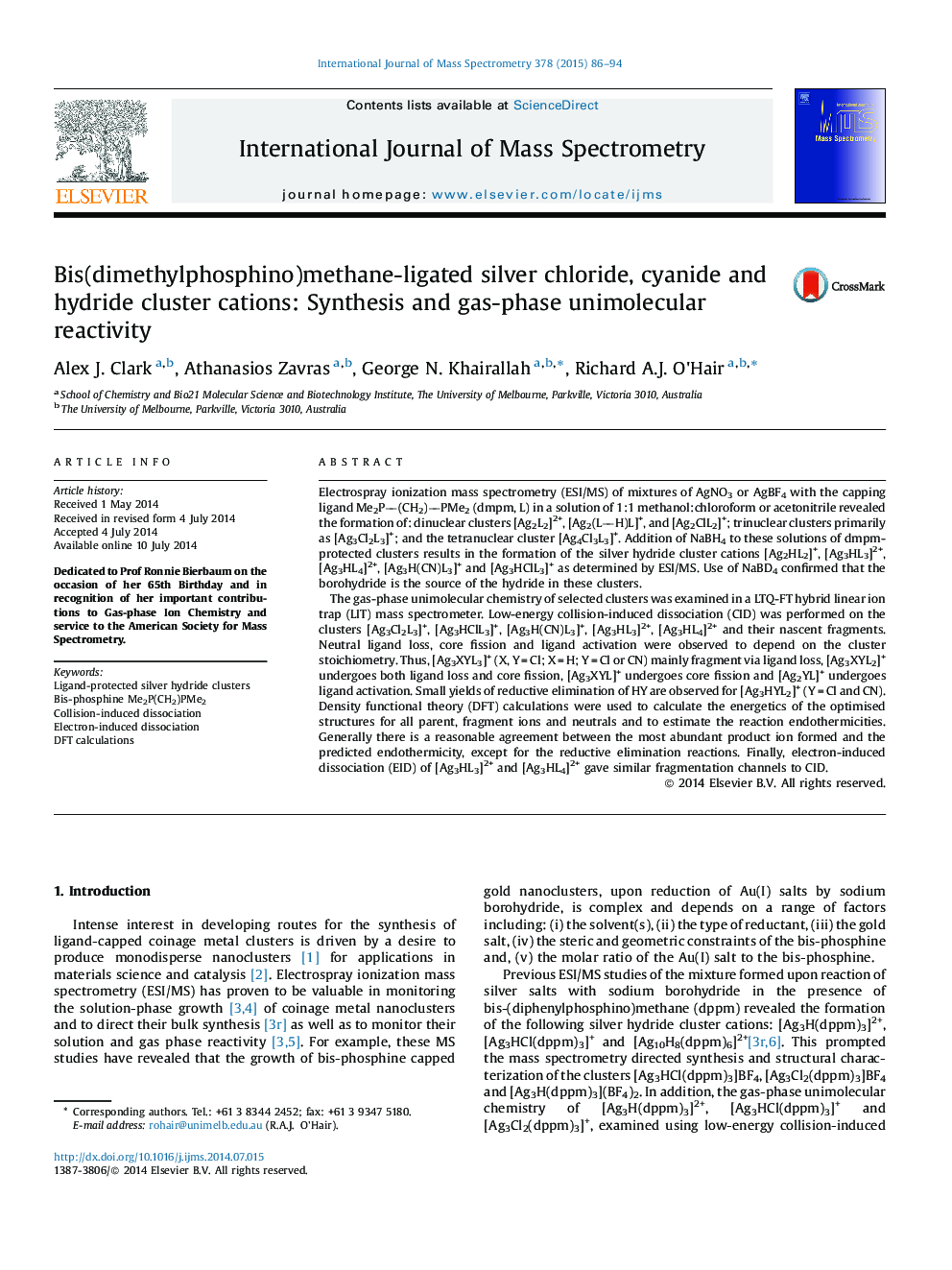| کد مقاله | کد نشریه | سال انتشار | مقاله انگلیسی | نسخه تمام متن |
|---|---|---|---|---|
| 1192084 | 1492250 | 2015 | 9 صفحه PDF | دانلود رایگان |

• Ionic bis(dimethylphosphino)methane (dmpm, L) protected silver chloride and silver hydride cluster cations were formed via condensed phase synthesis.
• ESI/MS reveals the formation of [Ag2(Cl)L2]+ and [Ag3(Cl)2L2]+ prior to addition of NaBH4.
• ESI/MS reveals the formation of [Ag3(H)L2]2+ and [Ag3(H)(Cl)L2]+ after addition of NaBH4.
• The unimolecular chemistry of each of these clusters was examined via CID and EID.
• A range of pathways appear for CID including dmpm loss, cluster fragmentation and CP bond activation of dmpm.
Electrospray ionization mass spectrometry (ESI/MS) of mixtures of AgNO3 or AgBF4 with the capping ligand Me2P(CH2)PMe2 (dmpm, L) in a solution of 1:1 methanol:chloroform or acetonitrile revealed the formation of: dinuclear clusters [Ag2L2]2+, [Ag2(LH)L]+, and [Ag2ClL2]+; trinuclear clusters primarily as [Ag3Cl2L3]+; and the tetranuclear cluster [Ag4Cl3L3]+. Addition of NaBH4 to these solutions of dmpm-protected clusters results in the formation of the silver hydride cluster cations [Ag2HL2]+, [Ag3HL3]2+, [Ag3HL4]2+, [Ag3H(CN)L3]+ and [Ag3HClL3]+ as determined by ESI/MS. Use of NaBD4 confirmed that the borohydride is the source of the hydride in these clusters.The gas-phase unimolecular chemistry of selected clusters was examined in a LTQ-FT hybrid linear ion trap (LIT) mass spectrometer. Low-energy collision-induced dissociation (CID) was performed on the clusters [Ag3Cl2L3]+, [Ag3HClL3]+, [Ag3H(CN)L3]+, [Ag3HL3]2+, [Ag3HL4]2+ and their nascent fragments. Neutral ligand loss, core fission and ligand activation were observed to depend on the cluster stoichiometry. Thus, [Ag3XYL3]+ (X, Y = Cl; X = H; Y = Cl or CN) mainly fragment via ligand loss, [Ag3XYL2]+ undergoes both ligand loss and core fission, [Ag3XYL]+ undergoes core fission and [Ag2YL]+ undergoes ligand activation. Small yields of reductive elimination of HY are observed for [Ag3HYL2]+ (Y = Cl and CN). Density functional theory (DFT) calculations were used to calculate the energetics of the optimised structures for all parent, fragment ions and neutrals and to estimate the reaction endothermicities. Generally there is a reasonable agreement between the most abundant product ion formed and the predicted endothermicity, except for the reductive elimination reactions. Finally, electron-induced dissociation (EID) of [Ag3HL3]2+ and [Ag3HL4]2+ gave similar fragmentation channels to CID.
Figure optionsDownload high-quality image (124 K)Download as PowerPoint slide
Journal: International Journal of Mass Spectrometry - Volume 378, 15 February 2015, Pages 86–94